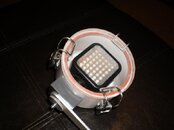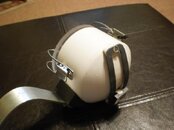Entacmaea
Registered
Hey everyone- new here, but have been reading and reading and got inspired by a couple of the threads on making dive lights, and am going to give it a try.
I'd like to make a combined night dive light, and camera video/focus light. What I know and have built with before in aquarium lighting is cree 3 watt 20mm stars. Would those be applicable here? This is what I would like to do (I'll be making a custom aluminum enclosure for these), but I am totally open to suggestions. I am especially looking for knowledge on the battery angle, as I have no experience with that. This will likely be a canister type light- something I can mount to both my wrist and to my camera housing.
Three or possibly four 5-watt Cree 5-Watt XM-L stars Max 3000mA, about 5000K, ~2.9v forward voltage each. Not sure how many lumens this would be, but aiming for about 750-1,500 from low to high power. Along with those, I'd like to run three 3-watt RED XP-E led's, MAX 700mA ~2.4v forward voltage (these I'd like on a separate switch, for finding critters at night...) Probably looking at individual 12-degree narrow lenses.
Ideally the 5-watt Cree white LED's would be on a dimmer, or somehow control their brightness. I would do this on a potentiometer normally running AC power, but not sure what options there are with batteries, or if they are the same. I've seen some flashlight circuit board drivers like this one: 4-Mode 2500mA LED Driver Circuit Board for Flashlight (DC 5.0~8.4V) - Free Shipping - DealExtreme which might work for the 5-watt white crees.
If I were doing this with AC power it would be no problem, but with batteries- not sure what to do. What rechargeable batteries would you suggest, in what configuration?
I saw these http://www.all-battery.com/asizenimh...batteries.aspx Which are 1.2V and 2500mA, so does that mean I would need about 6 or 8 to run the 3-4 CREE's above, slightly under driving them?
I could probably put the 3 red LED's on another circuit, as I need to drive them at significantly lower amperage and want independent control of them- do I need a different battery whose output is 700mA? I think I might be missing some fundamental formula for calculating what I need
 Help?
Help?
Thanks, Peter
I'd like to make a combined night dive light, and camera video/focus light. What I know and have built with before in aquarium lighting is cree 3 watt 20mm stars. Would those be applicable here? This is what I would like to do (I'll be making a custom aluminum enclosure for these), but I am totally open to suggestions. I am especially looking for knowledge on the battery angle, as I have no experience with that. This will likely be a canister type light- something I can mount to both my wrist and to my camera housing.
Three or possibly four 5-watt Cree 5-Watt XM-L stars Max 3000mA, about 5000K, ~2.9v forward voltage each. Not sure how many lumens this would be, but aiming for about 750-1,500 from low to high power. Along with those, I'd like to run three 3-watt RED XP-E led's, MAX 700mA ~2.4v forward voltage (these I'd like on a separate switch, for finding critters at night...) Probably looking at individual 12-degree narrow lenses.
Ideally the 5-watt Cree white LED's would be on a dimmer, or somehow control their brightness. I would do this on a potentiometer normally running AC power, but not sure what options there are with batteries, or if they are the same. I've seen some flashlight circuit board drivers like this one: 4-Mode 2500mA LED Driver Circuit Board for Flashlight (DC 5.0~8.4V) - Free Shipping - DealExtreme which might work for the 5-watt white crees.
If I were doing this with AC power it would be no problem, but with batteries- not sure what to do. What rechargeable batteries would you suggest, in what configuration?
I saw these http://www.all-battery.com/asizenimh...batteries.aspx Which are 1.2V and 2500mA, so does that mean I would need about 6 or 8 to run the 3-4 CREE's above, slightly under driving them?
I could probably put the 3 red LED's on another circuit, as I need to drive them at significantly lower amperage and want independent control of them- do I need a different battery whose output is 700mA? I think I might be missing some fundamental formula for calculating what I need

Thanks, Peter






